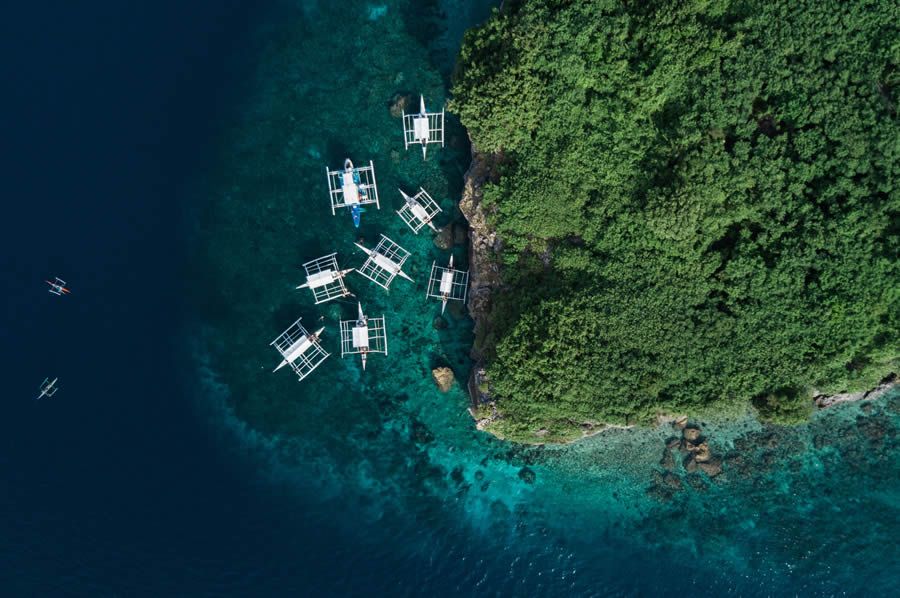Diving Camps in Thailand: Uncover the Best Underwater Experiences
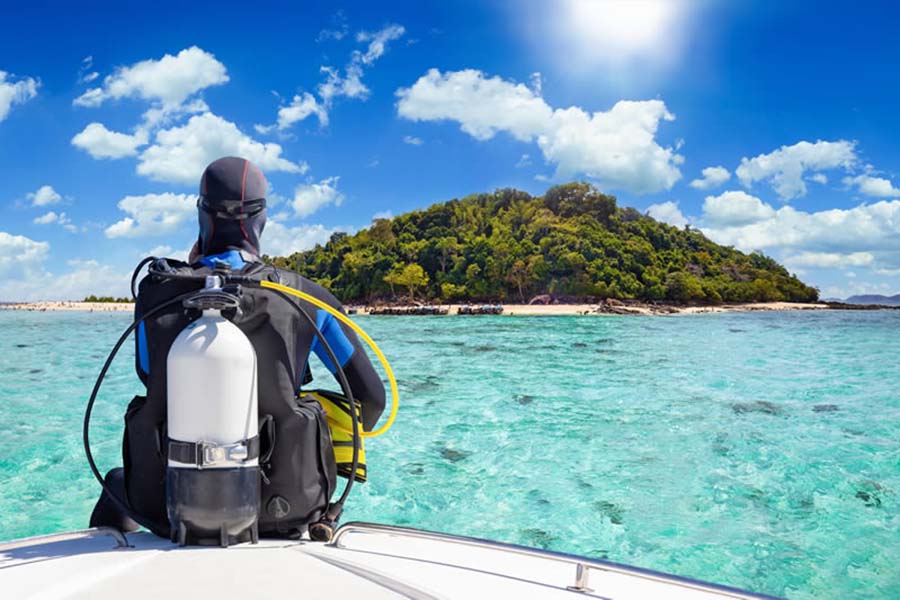
Thailand, a diving paradise, offers vibrant marine life, crystal-clear waters, and incredible dive sites for both beginners and experienced divers. With a tropical climate, the country boasts consistently comfortable water temperatures around 84°F/29°C, making it an ideal destination for scuba diving enthusiasts seeking an unforgettable underwater adventure.
The country features two distinct diving zones: the Andaman Sea and the Gulf of Thailand, each with opposite diving seasons to cater to varying preferences. Throughout Thailand, divers can explore diverse marine ecosystems, including some of the best diving sites, such as Hin Daeng, Hin Mouang, and Koh Tao. From schools of colorful fish to soft corals and encounters with manta rays or whale sharks, Thailand's underwater world promises a truly enchanting diving experience.
Several dive resorts and dive centers across Thailand provide comprehensive packages and courses for all skill levels. Whether you're seeking a PADI certification, an exploratory fun dive, or anything in between, Thailand’s diving scene is ready to accommodate all your underwater dreams.
- Top Diving Locations
- Marine Life
- Diving Conditions and Seasons
- Dive Sites and Features
- Choosing a Diving Camp in Thailand
- Liveaboard Diving
- Transportation to Dive Locations
- Travel Tips for Diving Enthusiasts
- Frequently Asked Questions
Top Diving Locations
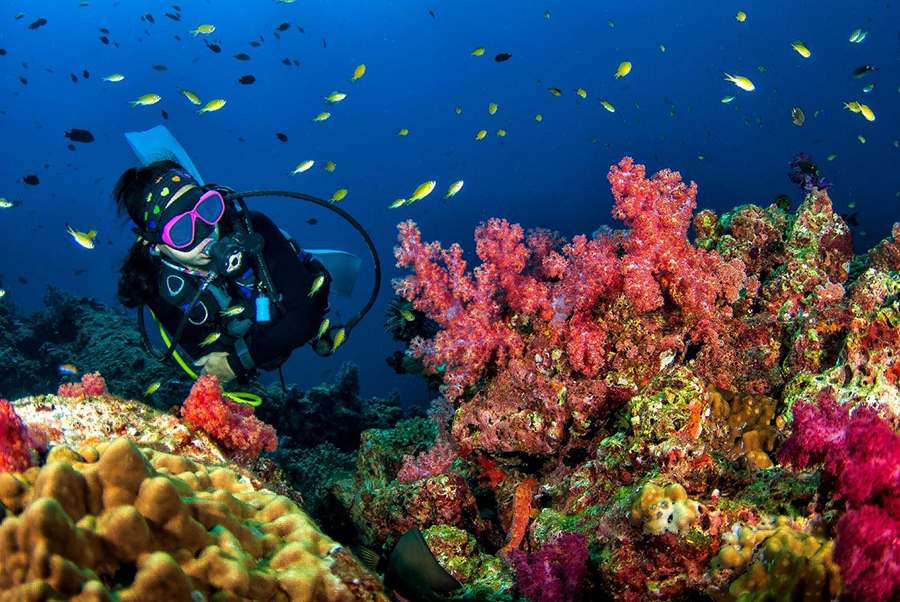
Thailand offers an array of incredible dive sites for enthusiasts to explore. This section will focus on the top diving locations in two major regions: the Andaman Sea and the Gulf of Thailand.
Andaman Sea
The Andaman Sea, located on the west coast of Thailand, is home to some of the country's most famous diving spots. Islands like Phuket, Koh Lanta, and Krabi serve as popular starting points for accessing the area's notable dive sites.
One of the most well-known locations in this region is the Similan Islands, offering vibrant coral reefs teeming with marine life. The Surin Islands are another top destination, boasting unique species and diverse hard and soft coral formations. Dive sites such as Hin Daeng and Hin Muang, known for their colorful soft corals and sightings of manta rays and whale sharks.
For experienced divers, Richelieu Rock near Koh Bon and Koh Tachai provides an opportunity to encounter whale sharks and other pelagic species. Koh Phi Phi offers numerous dive sites perfect for spotting leopard sharks and exploring underwater caves, while Koh Dok Mai is an ideal location for wall diving and discovering vibrant marine life.
Gulf of Thailand
The eastern coast of Thailand harbors the Gulf of Thailand, where popular destinations like Koh Samui, Koh Phangan, and Koh Tao can be found. Divers here can find a large variety of underwater experiences, from shallow reefs to deep-drop-offs.
Among the top diving spots in this region is Koh Tao, known for its stellar reputation as a hub for dive schools and affordable courses. Neighboring Chumphon Pinnacle attracts divers seeking encounters with whale sharks and bull sharks. Sail Rock, situated between Koh Phangan and Koh Tao, also demands attention with its spectacular underwater chimney and abundance of marine life.
Another notable dive location is Koh Lipe, boasting some of Thailand's most beautiful soft corals. The island is part of Tarutao National Marine Park and offers breathtaking underwater vistas, attracting divers from across the globe.
Marine Life

Thailand boasts a diverse and vibrant marine life, offering divers an underwater paradise with a myriad of species and colorful coral reefs. The Andaman Sea and the Gulf of Thailand are home to a vast array of marine creatures, providing a truly unforgettable diving experience.
One of the most sought-after sightings in Thai waters are the majestic manta rays and colossal whale sharks. These gentle giants glide gracefully through the water, offering divers an up-close encounter with some of the ocean's most mesmerizing creatures. The waters around Thailand are also known for their numerous leopard sharks, typically found resting on sandy bottoms and posing no threat to divers.
The coral reefs in Thailand are teeming with life, from small critters such as seahorses, ghost pipefish, and nudibranchs, to larger marine dwellers like moray eels and Napoleon wrasses. These reefs also host diverse populations of anemonefish and angelfish, including the vibrant tomato anemonefish and yellow-masked angelfish. In addition, barramundi can be spotted lurking in their natural habitat.
Many diving sites in Thailand, such as Hin Daeng and Hin Mouang, are recognized for their abundance of pelagic species, as well as unique macro life. These locations are perfect for observing seahorses, frogfish, and other intriguing creatures of the deep in their vibrant underwater environments.
In addition to the stunning marine life, divers can explore exciting topography, from caverns and tunnels to submerged pinnacles and seamounts. In this captivating underwater world, divers of all levels can gain an appreciation for the diverse range of species that inhabit Thailand's waters, making it a top destination for those seeking an unparalleled, marine-rich diving experience.
Diving Conditions and Seasons
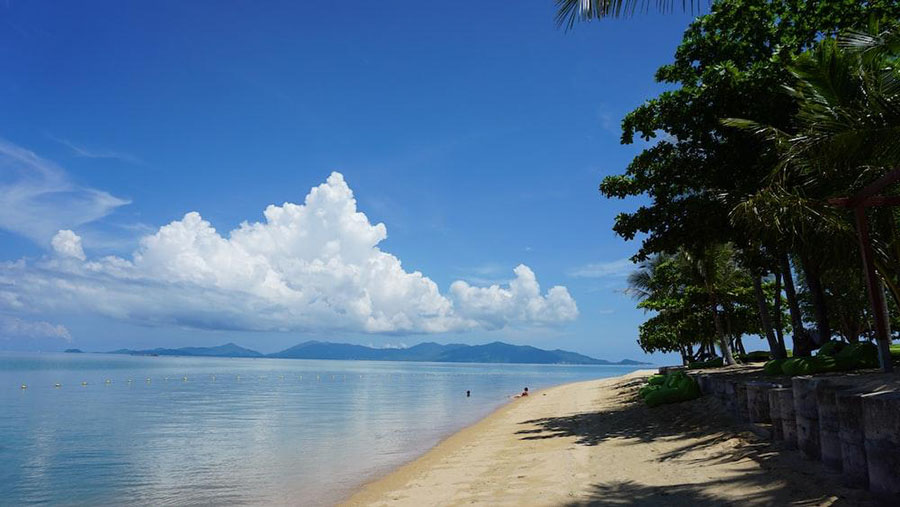
Thailand boasts of a fascinating underwater world with its clear waters and abundant marine life, making it a popular choice among diving enthusiasts. This diverse and vibrant destination offers exciting diving experiences all year round, but understanding the diving conditions and seasons can help divers make the most of their trip.
Thailand's dive sites are spread across two main regions, the Andaman Sea to the west and the Gulf of Thailand to the east. The water temperatures in both areas remain comfortably warm throughout the year, hovering around 84°F/29°C, allowing divers to enjoy extended dive times without any discomfort.
Visibility in Thailand is generally excellent, ranging from 65-100ft (20-30m) and occasionally exceeding 130ft (40m) in some sites. This clear water provides divers with a good view of the colorful coral reefs and diverse marine life that thrives in these waters.
Diving conditions vary depending on the region and time of the year. For the Andaman Sea, the prime diving season starts in October and lasts till May, with the best conditions experienced between February and April. This period coincides with the dry and calm weather, ensuring optimal diving conditions, especially in famous dive sites like the Similan and Surin Islands.
On the other hand, the Gulf of Thailand experiences its peak diving season from May to September. During this time, the east coast dive sites such as Koh Tao, Koh Samui, and Koh Phangan offer calm waters and exceptional visibility.
It is important to keep in mind that some destinations, such as the Similan and Surin Islands, are closed for a few months each year due to weather conditions and conservation efforts. These closures typically happen between mid-May to mid-October, making it crucial for divers to plan their trips accordingly.
In conclusion, understanding the diving conditions and seasons in Thailand can significantly enhance a diver's experience. With the proper planning and consideration of regional weather patterns, divers can enjoy the best of what Thailand's diverse marine environment has to offer.
Dive Sites and Features
Thailand offers a diverse range of dive sites, catering to everyone from beginners to experienced divers. Its waters are home to a variety of fascinating features such as wrecks, caverns, tunnels, pinnacles, walls, and rock formations. These sites attract a wide array of marine life, making Thailand a popular destination for scuba diving enthusiasts.
The Andaman Sea on the west coast and the Gulf of Thailand on the east coast showcase a spectacular underwater world. Divers can explore fringing reefs, deep drop-offs, and walls amidst crystal-clear waters. Furthermore, Thailand's dive sites are known to be populated with big fish species like manta rays and whale sharks.
One of the best diving sites in Thailand is Hin Daeng, which offers an exquisite experience with beautiful soft corals and the chance to spot manta rays and even whale sharks. Another noteworthy site is Hin Mouang (Purple Rock), known for its vibrant purple soft corals and abundant marine life.
Thailand is also home to 110 dive sites, including 88 reef dives, 20 ocean dives, and 20 wall dives. As a result, divers have a plethora of options when it comes to choosing their ideal dive site. For instance, Stonehenge Drift Pinnacle Reef is an exceptional site with unique rock formations and abundant marine life.
For divers who wish to venture further, the Mu Koh Surin National Park offers five stunning islands north of the Similan Islands, with equally incredible dive sites. These remote islands are best accessed by booking a liveaboard trip.
In summary, Thailand's dive sites boast an extensive range of features, catering to a variety of skill levels and preferences. From mesmerizing rock formations to thrilling deep drop-offs, wrecks, and walls, Thailand has something for everyone in the scuba diving community.
Choosing a Diving Camp in Thailand
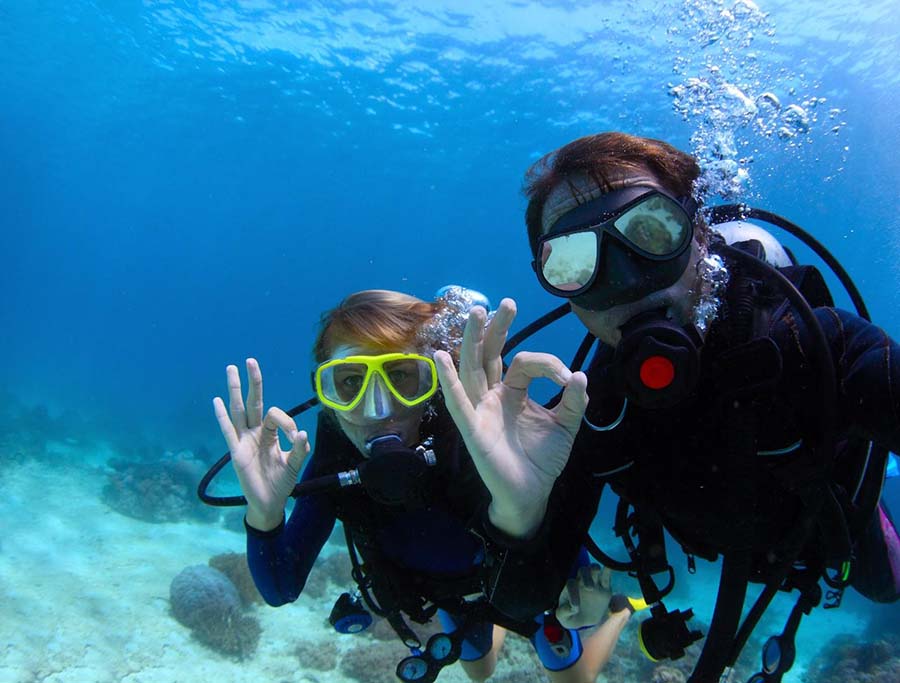
Beginner Divers
For those new to diving, it's essential to find a camp that provides the necessary training and support. Many diving centers in Thailand cater to beginners, offering PADI courses and introductory dives, ensuring a memorable and safe experience. Some of the top diving destinations for beginners include Koh Tao, known for its shallow, calm waters, and the Andaman coast's Similan Islands, which boast clear visibility and abundant marine life.
In Asia, particularly Thailand, beginners can immerse themselves in beautiful coral reefs and encounter fascinating marine creatures like turtles, clownfish, and friendly reef sharks. Some highly recommended camps for beginners are DIVEIN and PADI.
Intermediate Divers
Intermediate divers seeking to expand their skills should look for camps providing a range of dives, including deeper sites, wall dives, and drift dives. Richelieu Rock and Koh Phi Phi are popular destinations for intermediate divers, with exciting marine life encounters like manta rays and whale sharks.
Several camps offer advanced certification courses and specialty courses, helping you hone your diving skills. Consider joining camps like Thailand Swimming Training Camps and TFT Swimming Camps to further your diving abilities and explore new challenges.
Expert Divers
Thailand has several challenging dive sites for experienced divers, including some with technical diving opportunities. Hin Daeng and Hin Mouang, for instance, are renowned for their thrilling diving adventures among stunning soft corals, manta rays, and even whale sharks.
Expert divers can also explore various wrecks, caves, and underwater canyons. It is essential to choose a camp affiliated with experienced dive guides who understand the local conditions and dive sites, ensuring your safety and the quality of your experience.
Liveaboard Diving
Thailand's Andaman Sea and Similan Islands offer some of the world's best liveaboard diving experiences. With warm waters, a rich variety of marine life, and calm conditions, travelers flock to Thailand for the ultimate underwater adventure. Liveaboard diving trips cover well-known locations and often cater to different skill levels, from beginners to experienced divers.
There are numerous top-rated liveaboards in Thailand, with options to suit various budgets and preferences. Tour packages often include accommodation, meals, and multiple dives per day, providing an all-inclusive experience. For instance, the Sawasdee Fasai offers superb services starting from $146 per day, while the Smiling Seahorse starts at $159 per day.
Liveaboard diving has other advantages, such as accessing remote dive sites that may otherwise be unreachable by day trips. Divers on liveaboards can explore beautiful coral reefs, cliffs, and underwater caves, and experience encounters with whale sharks, manta rays, and countless species of tropical fish.
The best time to embark on a liveaboard diving trip in Thailand is from November to April, as the waters are at their calmest. Notably, manta ray and whale shark sightings are more likely to occur between February and April. Keep in mind that Thailand is a beginner-friendly destination for liveaboard diving, making it an ideal choice for new divers to explore the underwater world.
In summary, liveaboard diving in Thailand offers a remarkable experience for divers of all skill levels. With top-quality services, abundant marine life, and access to some of the most stunning dive sites, it's no surprise that liveaboard diving in the Andaman Sea and Similan Islands is regarded as a must-try activity for underwater enthusiasts./p>
Transportation to Dive Locations
When planning a diving trip to Thailand, getting to the dive locations is an important aspect to consider. Thailand has multiple international airports, making it convenient for tourists coming from different parts of the world. The main airport in the country is Suvarnabhumi International Airport (BKK), located in Bangkok. This airport serves as a hub for many national and international flights, making it a common choice for travelers.
Once you arrive at the international airport, there are various transportation options available to reach your desired dive locations. Domestic flights can be booked from Suvarnabhumi to regional airports close to popular dive sites. For instance, if you plan to dive in the Similan Islands, you can catch a flight to Phuket International Airport (HKT) and then book a liveaboard package.
In addition, Thailand offers extensive train and bus networks that connect major cities to coastal areas. These options are often more economical but can take longer compared to domestic flights. For example, travelers can take a train or a bus from Bangkok to the coastal town of Khao Lak, a popular access point for iconic dive sites like the Boonsung Wreck, the Similan Islands, Richelieu Rock, Koh Bon, and Koh Tachai Pinnacle.
Alternative transportation options include private car hire or taxi services, which are readily available throughout the country. These services may be more expensive but offer the convenience of personalized and flexible travel. Some resorts and dive centers also provide airport pick-up and transfer, which you may want to inquire about when making your booking.
To summarize, reaching dive locations in Thailand primarily involves flying into an international airport, such as Suvarnabhumi, and then using various transportation options like domestic flights, trains, buses, or private vehicles to reach your destination. Planning your travel based on your preferred diving sites, time constraints, and budget will help ensure a smooth and enjoyable experience during your diving adventure in Thailand.
Travel Tips for Diving Enthusiasts
Thailand, located in Southeast Asia, is a top destination for dive enthusiasts. Its warm waters, abundant marine life, and numerous dive sites make it an ideal location for divers of all levels.
When planning a diving trip to Thailand, it's important to choose the right time of the year to visit. The best diving season in the Andaman Sea runs from November to April, whereas the Gulf of Thailand offers optimal conditions from May to September.
Packing the appropriate gear is essential for a successful diving adventure in Thailand. Be sure to bring your dive certification card, logbook, and any necessary dive equipment. If you don't have your own gear, most dive centers offer rental equipment at reasonable prices.
Health and safety should be a priority for any dive enthusiast in Thailand. Be mindful of the dive conditions and your own physical limitations. It is recommended that you purchase travel insurance that covers diving-related accidents and emergencies. Stay well-hydrated and apply sunscreen to protect yourself from the tropical sun.
When choosing a dive center or camp in Thailand, it's crucial to go with a reputable and professional provider. Research your options and read reviews from fellow divers to ensure you have the best diving experience possible. Some popular dive locations in Thailand include Hin Daeng and Mu Koh Surin National Park.
To fully immerse yourself in Thailand's underwater world, consider joining a liveaboard diving trip. These multi-day excursions allow you to dive the best sites in the country, providing ample opportunities to encounter diverse marine life and explore pristine coral reefs.
Thailand is known for its warm hospitality and rich culture. Don't forget to engage with the locals, learn about their traditions, and sample the mouthwatering Thai cuisine. This combination of stunning dive experiences and cultural discovery makes Thailand a true paradise for dive enthusiasts.
Frequently Asked Questions
What are the average prices for scuba diving packages in Thailand?
The average prices for scuba diving packages in Thailand can vary depending on factors like the duration of the package, location, and type of dive. Typically, multi-day diving packages range from $100 to $300 or more, including equipment rental, dive boat costs, and professional dive guides. It's essential to research and compare different options to find a package that suits your needs and budget.
Which are the top diving schools in Koh Tao?
Koh Tao is a popular destination for diving enthusiasts, boasting several reputable dive schools. Some of the top diving schools in Koh Tao include Bans Diving Resort, Crystal Dive, and Big Blue Diving. Each school offers various PADI courses and diving excursions catering to beginners and experienced divers alike. Make sure to read reviews and do a bit of research to find a dive school that meets your requirements.
When is the best time of year for diving in Thailand?
Thailand's tropical climate and various dive locations make it a year-round diving destination. However, the best time for diving in Thailand is generally November to April, as the weather is calm and visibility is at its peak during this period. Keep in mind that the diving conditions might differ slightly between the Andaman Sea and the Gulf of Thailand, so it's crucial to factor in your desired location when planning your trip.
What is the cost of a PADI course in Thailand?
The cost of a PADI course in Thailand varies depending on the level of certification and dive center. On average, an Open Water Diver course costs around $300-$400, while more advanced courses like Rescue Diver or Divemaster can range from $400 to over $1,000. These prices typically include equipment rental, course materials, and certifications fees. It's essential to shop around and find a trustworthy dive center that offers high-quality training and value for money.
What locations offer the best diving experiences in Thailand?
Thailand has a plethora of fantastic diving locations, each offering unique experiences. Some of the best diving sites include the Similan Islands, renowned for their diverse marine life and coral gardens; Hin Daeng and Hin Muang, famous for their deep drop-offs and chances of spotting manta rays and whale sharks; and Koh Haa, which boasts a stunning underwater topography with caverns and swim-throughs.
What is the typical duration of a diving camp in Thailand?
The duration of a diving camp in Thailand usually depends on the type of program and your expertise level. For example, a PADI Open Water Diver course often takes about three to four days to complete, while more advanced courses and specialty training may take up to a week or longer. Liveaboard trips, which offer multiple dives per day and allow divers to explore remote dive sites, can also range from three to fourteen days. However, many dive centers and schools in Thailand offer flexible scheduling to accommodate individual preferences and time constraints.

Enjoy a Truly Unique CAMP
Experience With Fellow Travelers
SatoriCamp will match you next vacation with like-minded travelers from around the world.
Find your Camp





